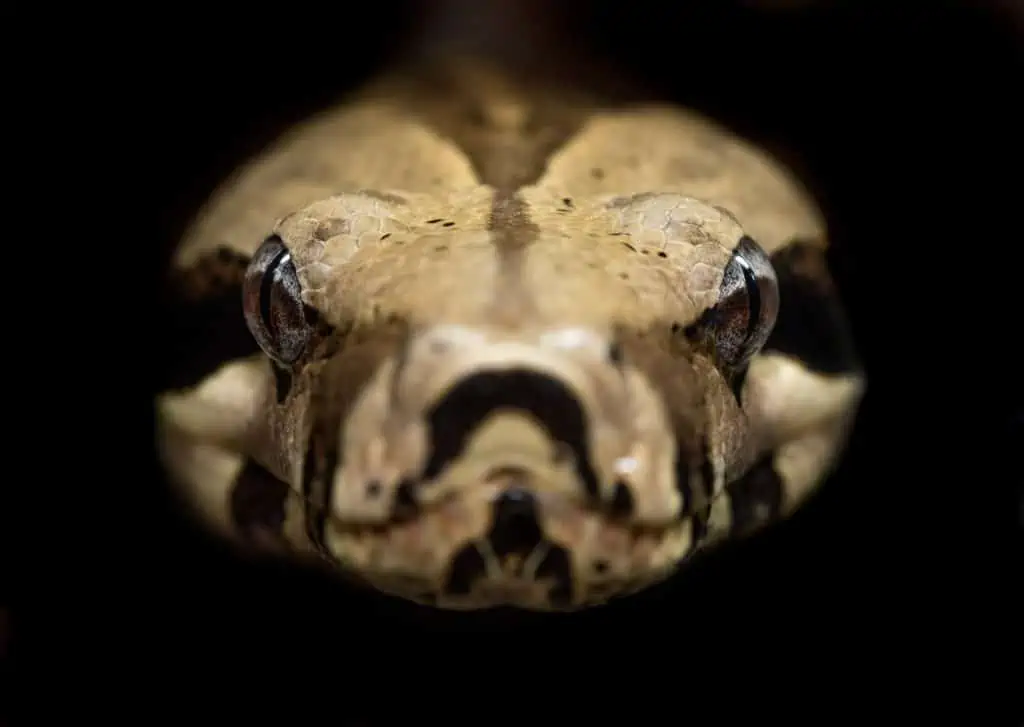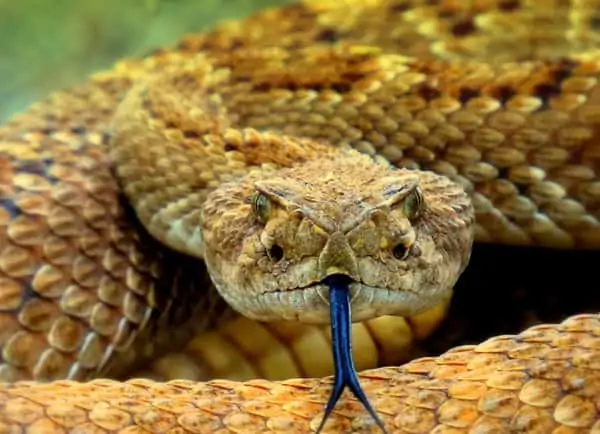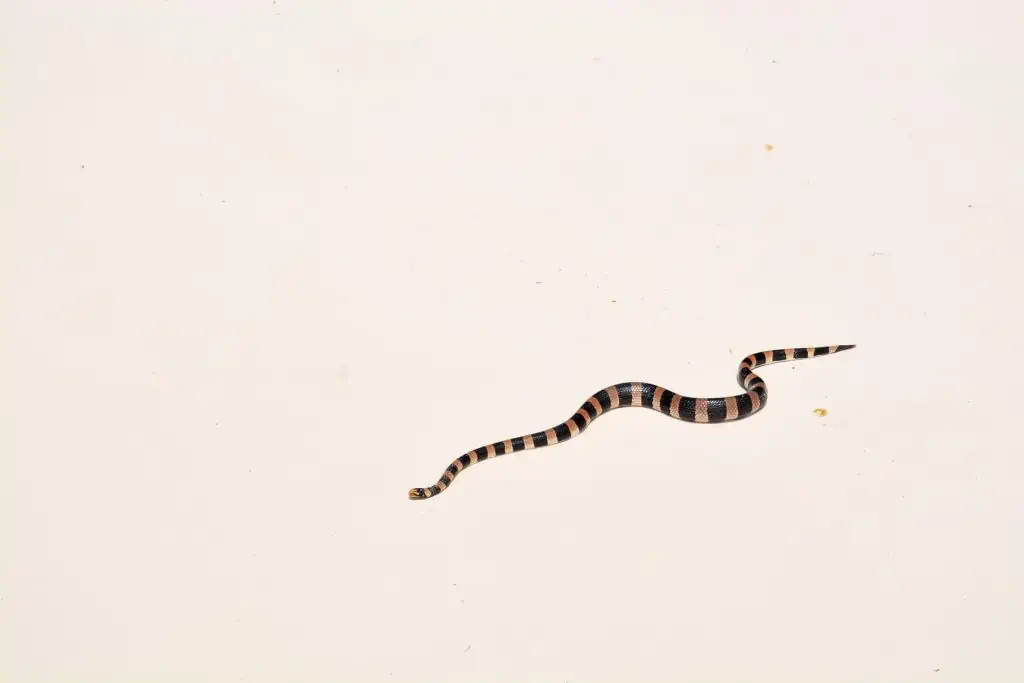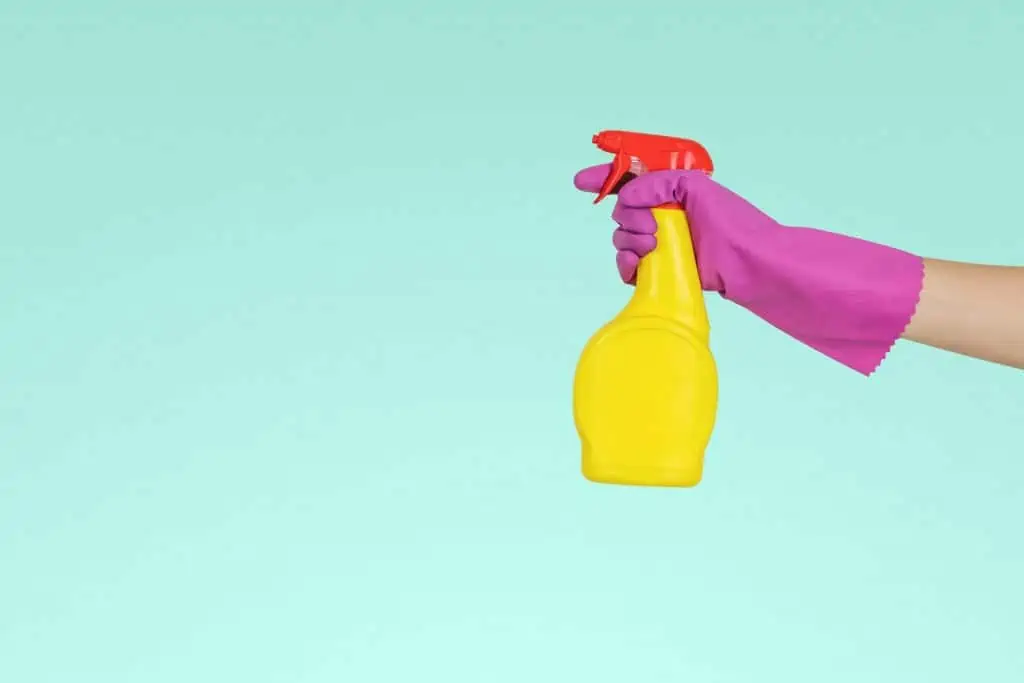Snakes in home — yikes!
Having a snake slither up from your toilet bowl or find one hiding in your clothes hamper is not a pleasant sight. It’s an even worse nightmare when you are at home with family and toddlers. This is why it’s absolutely vital to know how to get rid of snakes in home and how to keep them from getting back inside.
But why do you have snakes in home, and how can you protect yourself from these pests without putting yourself in danger?
Let’s find out!
Contents
But First, Let’s Talk About Snakes
Though they have a bad rap, snakes are actually beneficial animals.
Snakes are limbless, cold-blooded reptiles that are found on every continent except Antarctica. There are about 3,400 known species of snake throughout the world, and an estimated 150 species of snakes in the United States.
There are two types of snakes we contend with, including venomous snakes and non-venomous snakes.
Venomous Snakes:
Venomous snakes are either vipers or elapids. They have hollow fangs through which they inject venom into their prey. These fangs are usually long and curved, but some species have short fangs that may not be visible from the outside of their mouth.
Pit vipers include snakes like rattlesnakes, copperheads, cottonmouths and water moccasins. Elapids include snakes like coral snakes and cobras.
All of these snakes are all medically important to humans because the venom they produce can cause severe pain and in some cases death if not treated. For this reason, it’s very important for people to be aware of the types of venomous snakes that live in their region and to avoid picking snakes up unless they know for certain whether or not these snakes are venomous.
In the United States, there are about 30 species of venomous snakes to contend with. They include 23 species of rattlesnakes, three species of coral snakes, two species of copperhead snakes, and two species of cottonmouth snakes.
Non-Venomous Snakes:
Non-venomous snakes do not have hollow fangs through which they inject venom into their prey; instead, many will use constriction to kill their prey by suffocation. Constrictor snakes include boa constrictors, anacondas, pythons and yellow rat snakes.
These species kill their prey by squeezing it until its heart stops beating or it suffocates from lack of oxygenated blood reaching its organs. If you’re fearful of snakes, you’ll be happy to learn that at least 90% of snakes in the United States are non-venomous. Of course, that is not to say they will not strike or bite people.
Furthermore, very large snakes like boa constrictors can be dangerous to people due to their strength and ability to suffocate them.
Regardless of if they are venomous or not, snakes in general tend to get a bad rap. However, the truth is that these reptiles are actually more beneficial than they are problematic. In fact, snakes help keep the environment healthy and play a vital role in a well-rounded ecosystem.
This is because sneaks feast on a variety of pests that can wreak havoc on our property and in our gardens. For example, snakes help control pests and vermin like:
Of course, just because snakes are good for the environment does not mean you want to find snakes in home.
Why Do I Have Snakes In Home Issues?
Though many people keep snakes as pets, stumbling upon a snake Unexpectedly is unnerving.
Stumbling upon a snake in your home sounds like a nightmare, and it certainly can be if you have an innate fear of these slithering reptiles even when they’re leaving you be outdoors. Unfortunately, it is more common than you may think to come across unwelcome snakes in home situations.
According to the National Pest Management Association (NPMA), snakes can be found in homes for several reasons, including:
Open doors and windows – Snakes will often squeeze through small cracks and holes to gain access to your home. They also may enter through pet doors, open windows, or even entry doors that are accidentally left ajar.
Pipes – Many snakes are excellent climbers and will climb up pipes to enter your home through drain pipes or other areas where they can gain access to the inside of your walls.
Water sources – Snakes will often use water sources such as swimming pools or ponds as a way to get into your home by using them as a path into your property.
Snakes tend to seek out areas that are dark and quiet. These places include basements and crawl spaces — because they can use these places as shelter from predators and other threats. If you have an older home with a basement or crawl space, it’s likely that there is some type of access point that allows snakes to make their way inside.
As many as half of all snake bites occur indoors, according to the Centers for Disease Control and Prevention (CDC). Of course, this is due in part to the fact that some people keep these reptiles as pets or even catch them and bring them into their homes as novelty items.
Then there are the instances where people have unwittingly stumbled upon snakes in home, and the snake has bitten in an effort to protect itself.
While it is possible to discover snakes in homes in any location, for the most part, homes located in environments where snakes are more prevalent are at a higher risk of having snakes in home.
These environments would include homes located in desert regions, homes that back up to fields or greenbelts, homes near swamps or lakes, or homes near grasslands.
The time of year can also play a role in the likelihood of finding snakes in home. Most snakes hibernate during winter, and people have reported finding hibernating snakes in crawl spaces or basements during colder months.
Spring, summer, and fall may mean an influx of snakes in home if they are seeking dark, quiet spaces to nest or shelter away from predators.
Where To Look When Looking For Snakes In Home
Basements and crawlspaces make excellent hiding places for snakes.
If you do have snakes in home, it’s not very likely you’ll see them simply slithering across your living room floor. In fact, snakes prefer to stay away from humans, which means you’re much more likely to accidentally find the snakes.
Snakes tend to live under porches and in crawl spaces. If you find a snake in your home, it’s probably because there’s some kind of opening under your house that they can use as an entrance or exit point. You might also notice trails that lead back to their hiding place.
Snakes are solitary animals, so if you find a snake in your home, you likely only have that one snake to contend with. The exception to this rule is if it is during mating season, during hibernation season, or if a snake has laid eggs somewhere in your home and the baby snakes have hatched.
In these cases, you may have more than one snake in your home. If you are looking for snakes in this situation, it is important that you know where to look for them.
Snakes will typically hide under furniture or in other tight spaces. They like to go where they are protected from predators and can find food easily. They will also look for warmth, so don’t be surprised if you find snakes hiding behind heaters or radiators in your home.
Snakes like to live under porches and decks, so check there as well, as this could lead to snakes in home if you’re not careful.
While rare, it is possible that you may have a snake infestation without even knowing it because snakes are very good at hiding from humans. The best way to see if there are any snakes in your home is by doing an inspection with a flashlight on hand.
You will want to shine your flashlight around every corner of your house, especially under appliances, furniture and beds. Look for movement or twitching that could indicate that there is a snake close by.
Other signs of snakes in home include:
- A foul odor coming from a vent or wall
- Droppings along baseboards or on floorboards
- And shed snake skin inside the home
- Dead rodents or other pests snakes may prey on
Snakes In Home – Tips On Removing Snakes From The House Safely
Before you attempt to remove a snake from your home, it’s important to identify if it is venomous or not.
The first step in getting rid of snakes in home is to identify the type of snake or snakes you are dealing with. This can be done by looking at the snake’s markings or the shape of its head. Once you know what type of snake you’re dealing with, you can choose the best method for getting rid of it.
If you do have snakes in home, it’s important to remove them as quickly as possible. While most snakes in home are not likely to be venomous, they can cause other problems and are dangerous to people and pets by contaminating water sources or food sources.
In order to get rid of snakes in home effectively, it’s important to take the following steps:
First, Identify The Type Of Snake That Is In Your Home
Identifying the type of snake you have found in your home can be a difficult task and requires some knowledge of snakes and their characteristics. However, if you know what to look for, it is not that difficult.
The first thing that you want to do is try to identify the head of the snake. This will help you determine if it is venomous or not. If the head is triangular shaped, then it is a venomous snake.
If it has an arrow-shaped head then it is not a venomous snake, but instead a nonvenomous snake. If you’re still not sure of the type of snake you are dealing with, you can always try snapping a picture and using the internet to identify the snake or sending the image to a pest control expert for help.
Remove The Snakes Using Proper Products And Safety Gear
The first thing that you need to do is assess the situation and determine where the snake is hiding. Is it under the bed? Behind a cabinet? In the basement? Once you have an idea where it might be hiding, call your local wildlife removal professional for assistance.
If you’re on your own when dealing with a snake infestation, we recommend that you wear thick gloves and other forms of protection when handling them like long pants and long sleeves.
Of course, the best way to avoid being bitten by a snake is by not handling them in the first place.
Luckily, there are plenty of products like snake traps and snake grabbers you can invest in to help you collect, trap, and remove the snakes in home safely. However, if the snake is venomous, it’s best to contact a professional for snake removal unless you are certain you know what you are doing.
Finally, Work To Make Your Home Less Attractive To Snakes
After identifying and removing the snakes in home, your next step should be to ensure they do not come back. You can do this by ensuring you make your home less hospitable to snakes and certainly less attractive.
We will talk more about how to use repellents and other methods of prevention for getting rid of snakes in home further down.
But for now, if you’re not sure which products would work best to help you get rid of snakes in home, you’re in luck. We have listed some of the top rated products to remove snakes and keep your home snake free.
Ouronehome Professional Snake Tongs
No products found.
The Ouronehome Professional Snake Tongs are professional-grade snake tongs that allow you to safely retrieve and relocate snakes without having to make physical contact.
The tongs are made from high-quality steel, which makes them durable and strong enough to be used by professionals. The set also comes with a pair of gloves that help protect your hands from being bitten by the snake.
The tongs have a long reach so you can easily grab even large snakes. The gripping surface is covered in soft rubber, so it won’t damage the snake’s skin or scales. The rubber also helps prevent slippage, which means you’ll be able to hold on to the snake until it’s safely relocated.
These snake tongs are particularly useful if you live in an area where rattlesnakes are common and may come into contact with your home or yard.
FIPASEN Anti-Bite Work Gloves
No products found.
FIPASEN Anti-Bite Work Gloves are specifically designed for safe animal handling. They are long, riding all the way up to the elbow to help ensure safety and reduce the chances of being bitten when removing snakes from the home.
Made from durable and flexible leather, these gloves are also lightweight so you won’t be weighed down when trying to handle a snake. The gloves come in two sizes: small and large. The small is designed for most women or men with smaller hands while the large is designed for men with larger hands.
Both sizes feature an elastic wristband that prevents them from sliding off while you’re working with your snake. Each glove has additional padding on the back of it to protect against bites as well as an adjustable Velcro strap that keeps it securely in place on your hand at all times.
Harris Snake Glue Trap
No products found.
Harris Snake Glue Traps are ideal for snakes hiding in crawl spaces or in areas that may be difficult to reach by hand. You can leave these traps as well around your home and check them periodically to help catch any snakes you may not be aware are inside.
This trap is designed with a special coating that allows it to stay sticky longer than other traps. The bait is also formulated to attract the snake over a longer period of time. The glue on this trap is also designed to break down quickly after the snake has been trapped, allowing you to release it back into the wild without harm.
When you purchase Harris Snake Glue Traps, you will receive three glue boards per pack. Each board measures 12 inches x 9 inches and features four non-toxic glue strips along the top edge of each board. These strips are meant for use on all types of snakes, even venomous species like rattlesnakes, copperheads, cottonmouths and water moccasins (also known as cottonmouths).
How To Keep Snakes From Getting Back Inside Your Home
Routine home maintenance and getting rid of potential food sources are two ways to help prevent snakes in home.
If you’ve ever found a snake in your home, chances are it wasn’t there by choice. Snakes don’t like being inside houses and buildings, but sometimes they just get in. What can you do to keep them from coming back?
You can start by following the below tips:
- Make sure all doors and windows are securely closed and any gaps have been sealed.
- Use weather-stripping around doors, windows and vents in order to prevent snakes from entering your home.
- Keep vegetation trimmed back from the sides of your house as well as from beneath windows and decks. Snakes can hide or burrow in bushes, tall grasses and other plant growth near your home.
- Use screens on all exterior doors and windows that lead outside so that snakes can not crawl through them into your home.
Next, you’ll want to make sure that your home is snake-proof. If you have a crawl space under your house or a shed on your property, make sure that the areas under these structures are sealed up tight so that snakes cannot get into them.
You can also help keep snakes from getting back inside your home by investing in some quality snake control products, like those listed below.
Exterminators Choice Snake Defense Spray
No products found.
Exterminators Choice Snake Defense Spray is made with natural ingredients and is safe to use around people, pets, and the environment. The spray is perfect for use around your home or business. It contains a blend of natural oils that are proven effective at repelling snakes from your property.
This spray can be used both inside and outside to repel snakes, and it also works against other pests like mice, rats, and insects. The product comes in a large bottle that is easy to apply with a hand pump sprayer. Just a few quick sprays around the area you want to keep snakes away from and you’re done!
Neatmaster Ultrasonic Pest Repellent
No products found.
You can use the Neatmaster Ultrasonic Pest Repellent to repel snakes inside your home. This repeller works by emitting a high frequency sound that is not audible to humans but is very disturbing to snakes and rodents. The pests don’t like the sound, so they stay away from it.
For best results, place this device near areas where you have seen snakes or rodents. You can use it in attics and basements as well as on balconies and patios. This pest repeller is silent, so you won’t hear any buzzing or clicking noises when it’s operating. It also has an LED indicator light that lets you know when the device is working properly.
Home Remedies For Keeping Snakes Out Of Homes
Using ammonia and cleaning with ammonia based products can help repel snakes.
Snakes are quite sensitive to certain scents, environments, and sounds. This means you can use home remedies and homemade recipes to repel snakes and make your home less inviting to them.
Some of the most common home remedies you can use to help keep snakes out of your home are listed below:
Ammonia
Ammonia is a great snake repellent because it has a strong smell and will help deter snakes from coming into your yard or home. If you have an outdoor enclosure or pond, then ammonia is also an effective way to keep snakes away from these areas as well. You can use ammonia in combination with other repellents such as citronella oil, which will help make your home and yard less attractive for snakes and other pests like insects and rodents.
Peppermint Oil
Placing a few drops of peppermint oil on cotton balls and then placing them in areas where you have seen snakes entering your home. Peppermint oil is highly effective at repelling snakes from entering an area.
Cedar Shavings
Cedar is one of the best natural repellents for snakes in homes because snakes hate the smell of cedar. Cedar can be sprinkled in areas where it is not safe to place it directly on the ground. You can also place cedar mulch around your home, which will help keep snakes away from your house or garden.
Cedar chips are even often used in gardens and flower beds as a way of keeping snakes out of yards and gardens. The chips are not just a repellent, but they also have natural fertilizing properties that will boost plant growth in your yard or garden. The chips also have antifungal properties that inhibit mold growth and mildew on plants and flowers in your yard or garden.
Sage
Sage is a popular herb that can be used fresh or dried for a variety of purposes. When it comes to keeping snakes away from your home, sage leaves can be rubbed on windowsills, doorways and other areas where snakes like to hide or enter.
It’s best to rub the leaves on these areas during sunny days when they are fresh. You can also keep fresh sage in bowls around your home or hang bundles of it from door frames or windows. These herbs have been proven effective at keeping snakes away from homes in many different cultures since ancient times!
Vinegar
Snakes don’t like the smell of vinegar, so you can use this as another way to keep them away from your home. Pour some vinegar into small bowls or jars around your house so that it creates an unpleasant odor for any snakes who may venture into close proximity.
Other Tips And Tricks To Keeping Snakes Out Of Your Home
Though many people have a natural fear of snakes, remember that they are more beneficial than they are harmful.
The mere idea of finding snakes in home is enough to give you the shudders, but the good news is that it’s relatively simple to keep snakes out of your home simply by taking proactive steps.
According to experts, there are three major steps you can take to prevent snakes in your home in the future. These steps inclue keeping potential food sources out of your rhome, making your home and yard less hospitable to snakes, and installing snake mesh around your yard.
Keeping Potential Food Sources Out Of Your Home
This is probably the most important thing you can do. Snakes like to feast on mice, rats, birds and other small pests. Along with using a form of snake repellent, it’s also important to use other forms of pest repellent to ensure you are keeping potential snake prey away.
Some steps you can take to keep potential snake prey from your home include putting garbage in bins with tight lids, so that no rodents can get into them. Seal up holes in walls and foundations with cement mortar if necessary. Also store pet food and bird seed properly to keep smaller pests from becoming attracted to your yard and attracting snakes.
Make Your Yard Less Hospitable To Snakes
Snakes in home usually come from outside first, and they will be attracted to your yard if you have an abundance of overgrown grasses or brushy areas. These types of environments provide a place for these reptiles to hide from predators or sneak up on prey.
You can remove brush piles by using a rake or shovel to dig them out. Keep your yard clear of leaf litter as well, remove wood piles, and get rid of excess debris around your home.
You can also use landscaping fabric along your property lines to keep snakes out. Snakes are not able to crawl through the mesh of the fabric, so they will be forced to move elsewhere in search of food and shelter.
Install Snake Mesh Around Your Yard and Home
If you live in an area that has an abundance of snakes, you may be the perfect candidate for snake mesh or snake fencing. Snake mesh is a very durable and effective way to keep snakes out of your yard and, subsequently, out of your home.
Snake fencing is a heavy-duty fence made of metal or plastic that is designed to keep snakes out of your yard. You can purchase this type of fence online or at your local home improvement store. It also comes in many different sizes and colors to fit any landscape design.
And there you have it – the best methods, tips, and tricks for keeping snakes in home issues from repeating themselves.
So, have you ever had a snake in your home? Tell us your story in the comment section below! Thanks for reading!


Jack founded our blog after two decades of working in the pest control industry. His vast experience dealing with a wide array of pests allows him to diagnose issues quickly and get to the heart of pest problems quickly and effectively. He has serviced more than 2,000 homes over his career and there is hardly any pest situation that he has not seen before.







